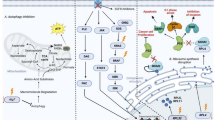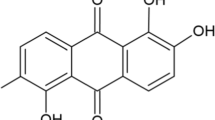Abstract
Purpose
This study was to evaluate the influence of mtDNA deletion on the lung cancer cells under the conditions of hypoxia or irradiation.
Method
The treatment conditions of lung cancer cell lines with (A549) and without mtDNA (ρ0A549: obtained by inducing from A549) included 2 h of hypoxia and 4 Gy irradiation (group 1: without treatment; group 2: 2 h of hypoxia; group 3: 4 Gy irradiation; group 4: 2 h of hypoxia plus 4 Gy irradiation). The Human OneArray™ microarray was used to hybridize with the Cy5-labeled aRNA in microarray sample preparation. Differentially expressed genes (DEGs) between the lung cancer cells with and without mtDNA were identified using NOISeq package in R. Gene ontology and Kyoto Encyclopedia of Genes and Genomes (KEGG) pathway analyses were performed using the online tool of DAVID.
Result
In the KEGG pathway analysis of down-regulated DEGs, nineteen pathways were simultaneously enriched in the four groups, which were mainly metabolism- and biosynthesis-related pathways. Nine lung cancer-related pathways were enriched in group 4, and more cancer-associated DEGs, such as MYC, MAX, and E2F1 were found in group 4 than in the other groups.
Conclusion
The mtDNA deletion could inhibit the biosynthesis and metabolism of lung cancer cells and promote the effect of hypoxia and radiation on lung cancer cells. MYC might be the key gene of the cooperation of hypoxia and radiation and MYC, MAX, and E2F1 might play roles in hypoxia- and radiation-induced cell death in lung cancer cells without mtDNA.


Similar content being viewed by others
References
Spruit MA, Janssen PP, Willemsen SC, Hochstenbag MM, Wouters EF (2006) Exercise capacity before and after an 8-week multidisciplinary inpatient rehabilitation program in lung cancer patients: a pilot study. Lung Cancer 52(2):257–260
Siegel R, Naishadham D, Jemal A (2013) Cancer statistics, 2013. CA Cancer J Clin 63(1):11–30
Ferlay J, Steliarova-Foucher E, Lortet-Tieulent J, Rosso S, Coebergh J, Comber H, Forman D, Bray F (2013) Cancer incidence and mortality patterns in Europe: estimates for 40 countries in 2012. Eur J Cancer 49(6):1374–1403
Chang S, Dai M, Ren J, Chen Y, Guo L (2012) [Estimates and prediction on incidence, mortality and prevalence of lung cancer in China in 2008]. Zhonghua liu xing bing xue za zhi = Zhonghua liuxingbingxue zazhi 33(4):391–394
Toyooka S, Mitsudomi T, Soh J, Aokage K, Yamane M, Oto T, Kiura K, Miyoshi S (2011) Molecular oncology of lung cancer. General Thorac Cardiovasc Surg 59(8):527–537
Ding C, Li R, Wang P, Fan H, Guo Z (2012) Sequence polymorphisms of the mitochondrial displacement loop and outcome of non-small cell lung cancer. Exp Ther Med 3(5):861–864
Ding C, Li R, Wang P, Jin P, Li S, Guo Z (2012) Identification of sequence polymorphisms in the D-loop region of mitochondrial DNA as a risk factor for lung cancer. Mitochondrial DNA 23(4):251–254
Hosgood HD, Liu C-S, Rothman N, Weinstein SJ, Bonner MR, Shen M, Lim U, Virtamo J, Cheng W-l, Albanes D (2010) Mitochondrial DNA copy number and lung cancer risk in a prospective cohort study. Carcinogenesis 31(5):847–849
Lin C-S, Wang L-S, Tsai C-M, Wei Y-H (2008) Low copy number and low oxidative damage of mitochondrial DNA are associated with tumor progression in lung cancer tissues after neoadjuvant chemotherapy. Interact CardioVasc Thorac Surg 7(6):954–958
Zheng S, Qian P, Li F, Qian G, Wang C, Wu G, Li Q, Chen Y, Li J, Li H (2012) Association of mitochondrial DNA variations with lung cancer risk in a Han Chinese population from southwestern China. PLoS One 7(2):e31322
Akgul EO, Kurt B, Gulcan KY, Cayci T (2013) MtDNA depletions and deletions may also be important in pathogenesis of lung cancer. Respir Med 107(11):1814
X-l LING, Y-l LU, Z-y DU (2005) Mitochondrial DNA deletion on the growth and invasiveness of human lung cancer cells [J]. Acta Acad Med Mil Tert 14:013
Lanni TB Jr, Grills IS, Kestin LL, Robertson JM (2011) Stereotactic radiotherapy reduces treatment cost while improving overall survival and local control over standard fractionated radiation therapy for medically inoperable non-small-cell lung cancer. Am J Clin Oncol 34(5):494–498
Basaki K, Abe Y, Aoki M, Kondo H, Hatayama Y, Nakaji S (2006) Prognostic factors for survival in stage III non-small-cell lung cancer treated with definitive radiation therapy: impact of tumor volume. Int J Radiat Oncol Biol Phys 64(2):449–454
Eriksson D, Stigbrand T (2010) Radiation-induced cell death mechanisms. Tumor Biol 31(4):363–372
St Clair DK, Steven Wan X, Oberley TD, Muse KE, St Clair WH (1992) Suppression of radiation-induced neoplastic transformation by overexpression of mitochondrial superoxide dismutase. Mol Carcinog 6(4):238–242
Garofalo C, Capristo M, Manara MC, Mancarella C, Landuzzi L, Belfiore A, Lollini P-L, Picci P, Scotlandi K (2013) Metformin as an adjuvant drug against pediatric sarcomas: hypoxia limits therapeutic effects of the drug. PLoS One 8(12):e83832
Kumar P (2000) Tumor hypoxia and anemia: impact on the efficacy of radiation therapy. Seminars in hematology. Elsevier, Amsterdam, pp 4–8
Martinez-Outschoorn UE, Trimmer C, Lin Z, Whitaker-Menezes D, Chiavarina B, Zhou J, Wang C, Pavlides S, Martinez-Cantarin MP, Capozza F (2010) Autophagy in cancer associated fibroblasts promotes tumor cell survival: role of hypoxia, HIF1 induction and NFκB activation in the tumor stromal microenvironment. Cell Cycle 9(17):3515
Papandreou I, Lim A, Laderoute K, Denko N (2008) Hypoxia signals autophagy in tumor cells via AMPK activity, independent of HIF-1, BNIP3, and BNIP3L. Cell Death Differ 15(10):1572–1581
R-h Xu, Pelicano H, Zhou Y, Carew JS, Feng L, Bhalla KN, Keating MJ, Huang P (2005) Inhibition of glycolysis in cancer cells: a novel strategy to overcome drug resistance associated with mitochondrial respiratory defect and hypoxia. Cancer Res 65(2):613–621
Zhang H, Gao P, Fukuda R, Kumar G, Krishnamachary B, Zeller KI, Dang CV, Semenza GL (2007) HIF-1 inhibits mitochondrial biogenesis and cellular respiration in VHL-deficient renal cell carcinoma by repression of C-MYC activity. Cancer Cell 11(5):407–420
Koshikawa N, Hayashi J-I, Nakagawara A, Takenaga K (2009) Reactive oxygen species-generating mitochondrial DNA mutation up-regulates hypoxia-inducible factor-1α gene transcription via phosphatidylinositol 3-kinase-Akt/protein kinase C/histone deacetylase pathway. J Biol Chem 284(48):33185–33194
Quintero M, Mackenzie N, Brennan P (2004) Hypoxia-inducible factor 1 (HIF-1) in cancer. European J Surg Oncol (EJSO) 30(5):465–468
King MP, Attardi G (1996) Isolation of human cell lines lacking mitochondrial DNA. Methods Enzymol 264:304–313
Diaz F, Bayona-Bafaluy MP, Rana M, Mora M, Hao H, Moraes CT (2002) Human mitochondrial DNA with large deletions repopulates organelles faster than full-length genomes under relaxed copy number control. Nucleic Acids Res 30(21):4626–4633
Tarazona S, García-Alcalde F, Dopazo J, Ferrer A, Conesa A (2011) Differential expression in RNA-seq: a matter of depth. Genome Res 21(12):2213–2223
Consortium GO (2004) The gene ontology (GO) database and informatics resource. Nucleic Acids Res 32(suppl 1):D258–D261
Ogata H, Goto S, Sato K, Fujibuchi W, Bono H, Kanehisa M (1999) KEGG: Kyoto encyclopedia of genes and genomes. Nucleic Acids Res 27(1):29–34
Dennis G Jr, Sherman BT, Hosack DA, Yang J, Gao W, Lane HC, Lempicki RA (2003) DAVID: database for annotation, visualization, and integrated discovery. Genome Biol 4(5):P3
Zhao M, Sun J, Zhao Z (2013) TSGene: a web resource for tumor suppressor genes. Nucleic Acids Res 41(D1):D970–D976
Chen J-S, Hung W-S, Chan H-H, Tsai S-J, Sun HS (2013) In silico identification of oncogenic potential of fyn-related kinase in hepatocellular carcinoma. Bioinformatics 29(4):420–427
Hatefi Y (1985) The mitochondrial electron transport and oxidative phosphorylation system. Annu Rev Biochem 54(1):1015–1069
Dianov GL, Souza-Pinto N, Nyaga SG, Thybo T, Stevnsner T, Bohr VA (2001) Base excision repair in nuclear and mitochondrial DNA. Prog Nucleic Acid Res Mol Biol 68:285–297
Semenza GL (2002) Signal transduction to hypoxia-inducible factor 1. Biochem Pharmacol 64(5):993–998
Bellot G, Garcia-Medina R, Gounon P, Chiche J, Roux D, Pouysségur J, Mazure NM (2009) Hypoxia-induced autophagy is mediated through hypoxia-inducible factor induction of BNIP3 and BNIP3L via their BH3 domains. Mol Cell Biol 29(10):2570–2581
Velde CV, Cizeau J, Dubik D, Alimonti J, Brown T, Israels S, Hakem R, Greenberg A (2000) BNIP3 and genetic control of necrosis-like cell death through the mitochondrial permeability transition pore. Mol Cell Biol 20(15):5454–5468
Hayashi J, Ohta S, Kikuchi A, Takemitsu M, Goto Y-i, Nonaka I (1991) Introduction of disease-related mitochondrial DNA deletions into HeLa cells lacking mitochondrial DNA results in mitochondrial dysfunction. Proc Natl Acad Sci 88(23):10614–10618
Dewey WC, Ling CC, Meyn RE (1995) Radiation-induced apoptosis: relevance to radiotherapy. Int J Radiat Oncol Biol Phys 33(4):781–796
Motoori S, Majima HJ, Ebara M, Kato H, Hirai F, Kakinuma S, Yamaguchi C, Ozawa T, Nagano T, Tsujii H (2001) Overexpression of mitochondrial manganese superoxide dismutase protects against radiation-induced cell death in the human hepatocellular carcinoma cell line HLE. Cancer Res 61(14):5382–5388
Epperly MW, Sikora CA, DeFilippi SJ, Gretton JA, Zhan Q, Kufe DW, Greenberger JS (2009) Manganese superoxide dismutase (SOD2) inhibits radiation-induced apoptosis by stabilization of the mitochondrial membrane. Radiat Res 157(5):568–577
Wang J, Y-y Lu (2009) Mitochondrial DNA 4977-bp deletion correlated with reactive oxygen species production and manganese superoxide dismutase expression in gastric tumor cells. Chinese Medical Journal (English Edition) 122(4):431
Berberich SJ, Cole MD (1992) Casein kinase II inhibits the DNA-binding activity of Max homodimers but not Myc/Max heterodimers. Genes Dev 6(2):166–176
Pelengaris S, Khan M (2003) The c-MYC oncoprotein as a treatment target in cancer and other disorders of cell growth. Expert opinion on therapeutic targets 7(5):623–642
Tanaka H, Matsumura I, Ezoe S, Satoh Y, Sakamaki T, Albanese C, Machii T, Pestell RG, Kanakura Y (2002) E2F1 and c-Myc potentiate apoptosis through inhibition of NF-κB activity that facilitates MnSOD-mediated ROS elimination. Mol Cell 9(5):1017–1029
Acknowledgments
This study was supported by NSFC (Natural Science Foundation of China) No. 81372531. We wish to express our warm thanks to Fenghe (Shanghai) Information Technology Co., Ltd. Their ideas and help gave a valuable added dimension to our research.
Conflict of interest
The author(s) declare that they have no competing interests.
Author information
Authors and Affiliations
Corresponding author
Additional information
The Publisher and Editor retract this article in accordance with the recommendations of the Committee on Publication Ethics (COPE). After a thorough investigation we have strong reason to believe that the peer review process was compromised.
About this article
Cite this article
Han, CB., Sun, L., Ma, JT. et al. RETRACTED ARTICLE: The Influence of mtDNA Deletion on Lung Cancer Cells Under the Conditions of Hypoxia and Irradiation. Lung 192, 997–1004 (2014). https://doi.org/10.1007/s00408-014-9639-9
Received:
Accepted:
Published:
Issue Date:
DOI: https://doi.org/10.1007/s00408-014-9639-9




